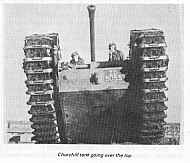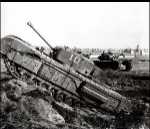


Copyright � An Cosantoir
Copyright � An Cosantoir
Copyright � An Cosantoir
The version in use with the Irish Army was the Mark VI, which was produced from December 1943, it was heavily armoured, maximum armour of 102mm, and mounted a 75mm OF Mk 5 gun. According to "Irish Army Vehicles", the gun had an maximum range of 2,000 yards with an AP round and 10,000 yards with a HE round. However, by all accounts, the gun was almost totally ineffective, even in 1944, against opposing tanks.
Four Churchills entered Irish service, all were ex British Army models with very low mileage and were reportedly in excellent condition upon their arrival. Two were delivered on December 20th, 1948, with a further one on December 24th and the last one on January 28th, 1949. Again, according to "Irish Army Vehicles", these were delivered under a five year, secret, lease deal with the British MoD, they were purchased in 1954.
The Churchills appeared to fit the Defence Forces requirements perfectly, as the DF considered Ireland unsuitable for tank warfare, and always considered tanks in the Infantry support role.
At this stage it is not known if any of the Churchills have been preserved in the army museum, in the Curragh, however, it appears that one (ZD 5055, photo above), which was buried in the Glen of Imall, in the '70s, was "exhumed" in 2002/3, presumably cleaned, and presented to the "North Irish Horse", a wartime regiment of the British Army from the North of Ireland (Capt. Terrance O'Neill, a Premier of the Stormont administration, in the late '60s/early '70s, served with this regiment in WWII).
| Vehicle Specification | ||
| Crew | 5 | . |
| Armament | 75 mm medium velocity gun | 1 x 7.92 mm MG coaxially and 1 x 7.92 mm in Hull |
| Combat Weight | 40 Tons | . |
| Length | 25 ft 2 ins. | . |
| Width | 10 ft 8 ins. | . |
| Height | 11 ft 4 ins. | . |
| Max. Speed | 15.5 mph/12.5 mph | Open road/ough Terrain |
| Cruise Speed | . | . |
| Range | 90 miles/145 Kms | Open road |
| Max. Vertical Step | mm | . |
| Max. Trench | 10 ft | . |
| Ballistic Protection | mm | All Round |
| Ballistic Protection | . | Up Armored |
| Ballistic Protection | . | . |
| Engine | Bedford twin six | 350 bhp/.Kw |
| Transmission | . | . |